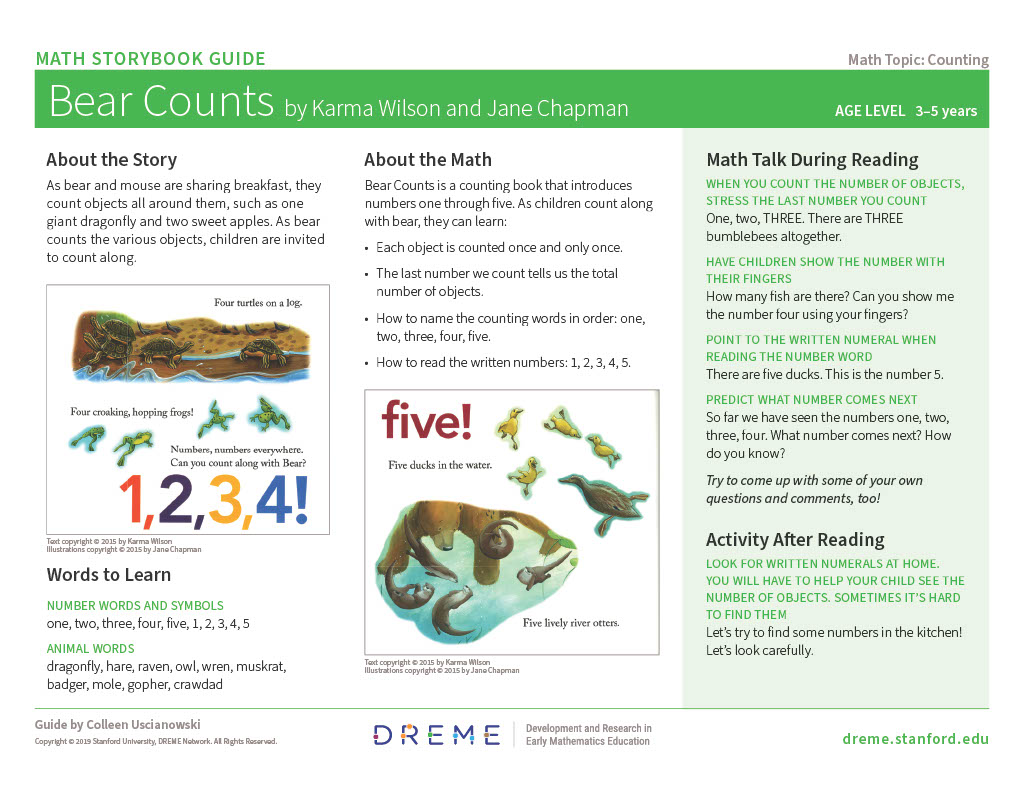You should read good math storybooks with your young child or class of preschool or kindergarten children. Why? One obvious reason is that the children might learn important math ideas. These storybooks cover many kinds of math, including numbers, shapes, measurement, pattern, spatial relations, and more.
Second, math storybooks—like other types of books—can be funny and exciting. They can help children enjoy math and books in general.
Third, reading any kind of interesting story can promote bonding between you and the child. This is particularly true of parents who cuddle with children as they read in bed before sleep.
Fourth, math storybook reading might just convince you, dear adult, that contrary to your school experience, math can be interesting and enjoyable.
What, then, are good math storybooks and how should you go about reading them to bring out the math?
We distinguish roughly between two types of math storybooks:
- One type is explicit. The titles of these books usually make clear that math is part of the story: “Anno’s Counting Book,” “Circus Shapes,” “Albert Adds Up!” and the like.
- The other type is implicit. These books do not seem to be about math, but they really are. They contain important, but informal, math ideas. For example, “The Three Bears” is all about order and one-to-one correspondence: the small, bigger, and biggest bears (Baby, Mama, and Papa) are arranged in one-to-one correspondence with the small, bigger, and biggest bowls of porridge and the small, bigger, and biggest beds.
We recommend reading both explicit and implicit math books with your children. To offer support around exploring math in picture books, we created math reading guides based on more than 60 storybooks, both explicit and implicit. The free guides are available online and in PDF format on the DREME Family Math website. Ten guides accompany Spanish books or wordless picture books. Several of the books have been recognized with a Mathical Book Prize for inspiring children to see math in the world around them.
You can search the collection by math topic and discover books that promote positive math identities. Every book is tagged with a suggested age level, but this is only an approximation. Feel free to overrule it given your knowledge of the children.

Each guide has the same format. The About the Story section provides a brief account of the plot, but does not give away the ending: “Will large Bear find the perfect place to live with his small family?” Note that the plot is about an emotional issue—loss of one’s home and friends—that must be almost traumatic for young children. But the driving force behind the emotional story is the mathematical idea of relative size: “Too small and crowded… Big enough for all… Just the right size.”
The next section is Words to Learn. The idea is that the reader should be aware of vocabulary, both math and non-math, that might be new or difficult for children. Our definition of a math word is broad. “Crowded” is not a formal math word, but in everyday math it signifies relative size, as when the Bear’s head pops through the roof of the ducks’ house.
About the Math makes explicit the informal math at the heart of the story. This section is particularly valuable for implicit math books, where even the adult reader could miss the math ideas and their importance in the story.
Each guide includes a section of ideas for Math Talk During Reading. It is important for the adult reader to know whether the child understands all the aspects of the story, pictures, plot, and ideas. To find out and explore together, the adult can have a conversation with the child. For example, the adult can hone in on the idea of relative size by asking, “Why does this home fit the ducks, but not the bear?” You can, of course, ask questions and make comments of your own, drawing upon the About the Math section of the guide.
Finally, the Activity After Reading offers simple and, hopefully, enjoyable activities that you can do with one child and often with a group of children after reading the story. The idea is to follow up on the math ideas, giving children an opportunity to talk about the important content.
Enjoy reading math storybooks together!



